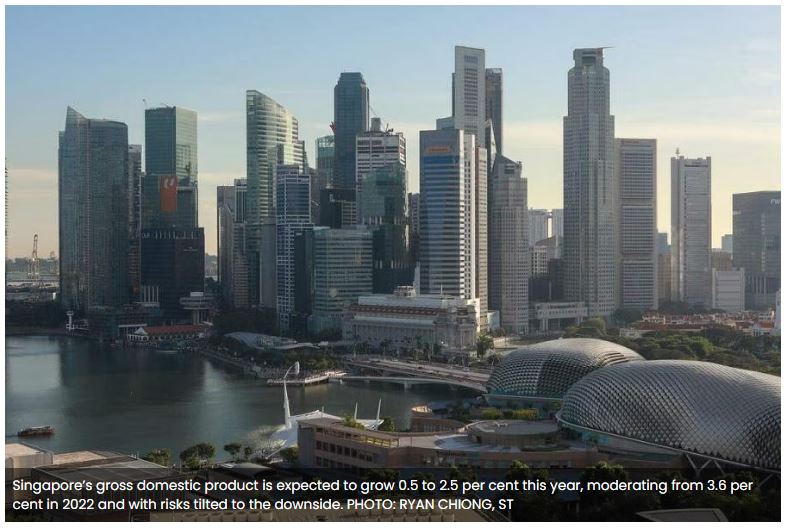Uncertainty, financial stability tail risks have risen globally and for Singapore: MAS
UNCERTAINTY and financial stability tail risks have increased both globally and in Singapore with the rise in global interest rates, the Monetary Authority of Singapore (MAS) said in its half-yearly macroeconomic review on Wednesday (Apr 26).
But it added: “For now, the swift and proactive response by policymakers to emerging vulnerabilities has been sufficient in preventing further downside risks from being built into the baseline.”
Monetary tightening is expected to cause both global growth and inflation to slow. MAS expects the global economy to grow 2.8 per cent, down from 3.3 per cent last year.
This slowdown will be primarily led by a slower 0.6 per cent growth in the G3 – the eurozone, Japan and the United States – down from 2.4 per cent last year. The US is expected to fall into a brief technical recession later this year, noted MAS.
While China will be an exception as its economy rebounds with the country’s reopening, this boost to Asian exports is not expected to offset the negative impact of weaker demand from advanced economies, said MAS.
For Singapore, MAS maintained its forecast for gross domestic product to grow 0.5 to 2.5 per cent this year, moderating from 3.6 per cent in 2022, but added: “The near-term outlook remains uncertain and fragile, with risks to growth skewed to the downside.”
The broadening downturn in the global electronics industry and the recent banking stresses in the US and Europe have dampened Singapore’s growth prospects, given the Republic’s relatively large exposure to the tech and finance sectors, it said.
Repeating an earlier warning about how “disorderly market adjustments and the exposure of latent vulnerabilities among corporates and households could increase financial stability risks”, MAS also flagged the danger of contagion from banking pressures.
“Should other latent vulnerabilities in the global financial system manifest in the coming months, consumer and investor confidence will take a further hit, with wider adverse implications for the economy beyond the current manufacturing-led downturn,” it said.
A contagion in financial markets could exacerbate the current trade downturn, with spillovers to domestic services, “thus dampening or even eliminating any recovery in the second half of the year”.
As for the labour market, the pandemic recovery is “broadly complete” but softening external demand is now expected to cause easing in labour market tightness and wage growth.
While unemployment rates remain below the pre-Covid-19 average, MAS noted nascent signs that labour market tightness has begun to ease. These include a decline in job vacancies and slowing labour market churn at the end of last year, indicating that job-hopping to higher-wage positions may have slowed.
There was also a slight pickup in retrenchments, as well as in employees placed on short work-week or temporary layoff in the fourth quarter, reaching levels similar to the pre-pandemic average.
In Q4 last year, there were early signs that external headwinds had dampened employment growth in the trade-related and modern services clusters, said MAS.
In Q4, only the domestic-oriented cluster saw manpower growth, as sales and activity approached pre-pandemic levels in retail trade, food and beverage services, as well as other community, social and personal services. In contrast, the construction sector saw a significant slowdown in headcount growth as the labour crunch eased.
For 2023, job creation in the more labour-intensive domestic-oriented and travel-related clusters is expected to offset the hiring slowdown and pockets of retrenchments in the trade-related and modern services clusters, MAS said. This means the aggregate resident workforce should continue expanding, albeit at a slightly more modest pace compared with last year.
It still expects the labour market to remain at full employment conditions through 2023, given its very tight starting point.
“The efficiency of matching job vacancies to jobseekers, which had fallen over the past few years, should also recover alongside increases in non-resident employment and job transformation efforts,” MAS said.
Source: https://www.businesstimes.com.sg/singapore/uncertainty-financial-stability-tail-risks-have-risen-globally-and-singapore-mas


 English
English




